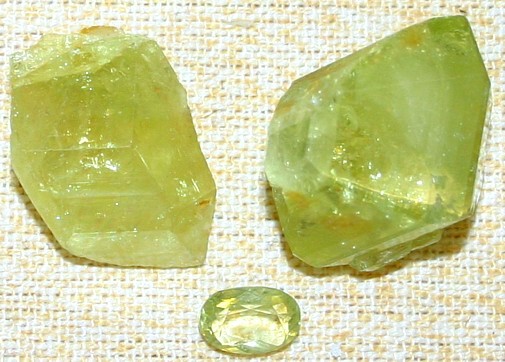|
.
Brazilianite
Mineral Facts:
Chemical
Formula: NaAl3(P04)2(0H)4
Sodium
Aluminum Phosphate-Hydroxide.
Colors:
Yellow, yellow green, colorless.
Hardness:
ranges 5.5
Density:
2.98
Cleavage:
One perfect cleavage
parallel to (010).
Crystallography: Monoclinic
Commonly found in prismatic crystals.
Transparent to translucent.
Luster:.
Vitreous
luster.
Optics:
(Refractive Index): =
1.60 to 1.62 |
 |
|
Composition, Structure and
Associated Minerals:
Brazilianite is
found in phosphate rich pegmatites. These igneous pegmatites
are rather unusual for their high phosphate content.
Associated minerals include
quartz, feldspars, muscovite as well
as pegmatite derived primary and secondary phosphates. Brazilianite is
a rare and unusual gemstone
and collector mineral. Along with
apatite and
turquoise, it is one of the few phosphate minerals to be used as a
serious gemstone. Although attractive, brazilianite would be un usual to see
in a commercial jewelry store and is still not well known. Brazilianite is relatively
uncommon, but makes for very fine mineral
specimens which sell well on the collector market.
Identification
and Diagnostics
Brazilianite
has an interesting and characteristic color, a yellow
to greenish yellow. Brazilianite can look little like
golden beryl or yellow
topaz
but brazilianite is much softer.
It is recognized by the presence of phosphate, its color, crystal form and
its comparatively low hardness.
|
 |
|
|
Localities
At the Galilea mine in Minas Gerais, Brazil,
some specimens are found perched on bundled leaves of muscovite which is
very attractive and find their way into museums and private collections. The
mineral occurs in well formed crystals up to 5 inches in length.
The principal
occurrences are found at Conselheiro Pena,
and near Mantena
in the state of Minas Gerias, Brazil.
In the US, it is found at the Palermo and the Charles Davis mines in Grafton
County, New Hampshire. Brazilianite was discovered in Brazil in 1945 and
when it was later found in New Hampshire at the Palermo Mine, it surprised many geologists
who had studied the pegmatite minerals there in detail and had somehow "missed" this new
mineral. Gem quality material comes from
Brazil and one location in New Hampshire, US.
While the crystals can be quite large, they are seldom flawless enough to
cut gems more than about 20 carats.
.Return
to the
Mineral Collectors Information Page
|


